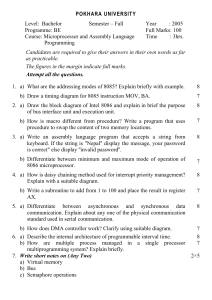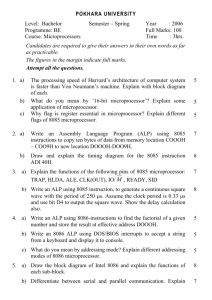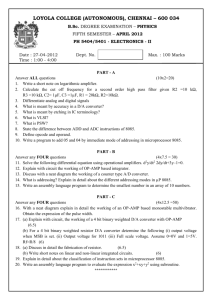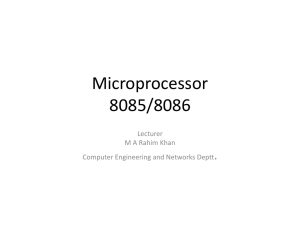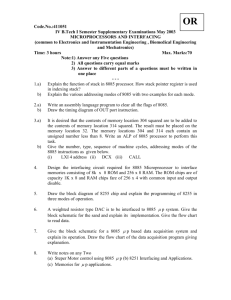2150707 - Gujarat Technological University
advertisement
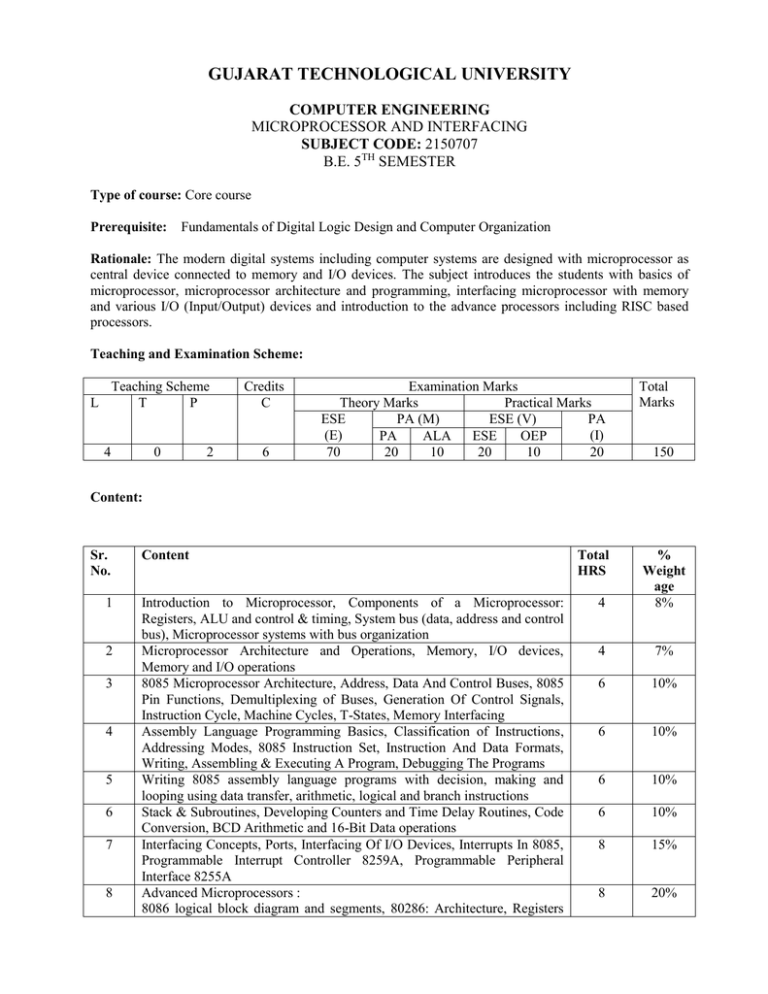
GUJARAT TECHNOLOGICAL UNIVERSITY COMPUTER ENGINEERING MICROPROCESSOR AND INTERFACING SUBJECT CODE: 2150707 B.E. 5TH SEMESTER Type of course: Core course Prerequisite: Fundamentals of Digital Logic Design and Computer Organization Rationale: The modern digital systems including computer systems are designed with microprocessor as central device connected to memory and I/O devices. The subject introduces the students with basics of microprocessor, microprocessor architecture and programming, interfacing microprocessor with memory and various I/O (Input/Output) devices and introduction to the advance processors including RISC based processors. Teaching and Examination Scheme: Teaching Scheme L T P 4 0 2 Credits C 6 Examination Marks Theory Marks Practical Marks ESE PA (M) ESE (V) PA (E) (I) PA ALA ESE OEP 70 20 10 20 10 20 Total Marks 150 Content: Sr. No. 1 2 3 4 5 6 7 8 Content Introduction to Microprocessor, Components of a Microprocessor: Registers, ALU and control & timing, System bus (data, address and control bus), Microprocessor systems with bus organization Microprocessor Architecture and Operations, Memory, I/O devices, Memory and I/O operations 8085 Microprocessor Architecture, Address, Data And Control Buses, 8085 Pin Functions, Demultiplexing of Buses, Generation Of Control Signals, Instruction Cycle, Machine Cycles, T-States, Memory Interfacing Assembly Language Programming Basics, Classification of Instructions, Addressing Modes, 8085 Instruction Set, Instruction And Data Formats, Writing, Assembling & Executing A Program, Debugging The Programs Writing 8085 assembly language programs with decision, making and looping using data transfer, arithmetic, logical and branch instructions Stack & Subroutines, Developing Counters and Time Delay Routines, Code Conversion, BCD Arithmetic and 16-Bit Data operations Interfacing Concepts, Ports, Interfacing Of I/O Devices, Interrupts In 8085, Programmable Interrupt Controller 8259A, Programmable Peripheral Interface 8255A Advanced Microprocessors : 8086 logical block diagram and segments, 80286: Architecture, Registers Total HRS 4 % Weight age 8% 4 7% 6 10% 6 10% 6 10% 6 10% 8 15% 8 20% 9 10 (Real/Protected mode), Privilege levels, descriptor cache, Memory access in GDT and LDT, multitasking, addressing modes, flag register 80386: Architecture, Register organization, Memory access in protected mode, Paging 80486 : Only the technical features Pentium : Architecture and its versions SUN SPARC Microprocessor: Architecture, Register file, data types and instruction format ARM Processor: Architecture features, Logical block diagram of ARM7 architecture 2 5% 2 5% Suggested Specification table with Marks (Theory): Distribution of Theory Marks R Level 12 U Level 20 A Level 24 N Level 6 E Level 4 C Level 4 Legends: R: Remembrance; U: Understanding; A: Application, N: Analyze and E: Evaluate C: Create and above Levels (Revised Bloom’s Taxonomy) Note: This specification table shall be treated as a general guideline for students and teachers. The actual distribution of marks in the question paper may vary slightly from above table. Reference Books: 1. Microprocessor Architecture, Programming, and Applications with the 8085, Ramesh S. Gaonkar Pub: Penram International. 2. Microprocessors and Interfacing, N. Senthil Kumar, M. Saravanan, S. Jeevanathan, S. K. Shah, Oxford 3. Advanced Microprocessors, Daniel Tabak, McGrawHill 4. Microprocessor & Interfacing - Douglas Hall, TMH 5. 8086 Programming and Advance Processor Architecture, Savaliya M. T., WileyIndia 6. The 8088 and 8086 Microprocessors, Triebel & Singh, Pearson Education Course Outcome: After learning the course the students should be able to: - List and specify the various features of microprocessor, memory and I/O devices including concepts of system bus. Identify the various elements of 8085 microprocessor architecture, its bus organization including control signals. List the pin functions of the 8085 microprocessor. Describe the 8085 processor addressing modes, instruction classification and function of each instruction and write the assembly language programs using 8085 instructions. Explain the concepts of memory and I/O interfacing with 8085 processor with Programmable devices. List and describe the features of advance microprocessors. List of Experiments: Practical list should be prepared based on the content of the subject and following guidelines should be useful. - 8085 assembly language programmes covering all the instructions. Interfacing practicals using I/O instructions Following list gives some programming examples. Teacher can prepare their own list in same manner keeping above guidelines and syllabus in mind. 1. Write an 8085 assembly language program for exchanging two 8-bit numbers stored in memory locations 2050h and 2051h. 2. Write an 8085 assembly language program to add two 8-bit numbers stored in memory locations 2050h and 2051h. Store result in location 2052h. 3. Write an 8085 assembly language program to add two 16-bit numbers stored in memory. 4. Write an 8085 assembly language program to add two decimal numbers using DAA instruction. 5. Write an 8085 assembly language program to find the minimum from two 8-bit numbers. 6. Write an 8085 assembly language program to get the minimum from block of N 8-bit numbers. 7. Write an 8085 assembly language program to add block of 8-bit numbers. 8. Write an 8085 assembly language program to find the number of 1’s binary representation of given 8-bit number. 9. Write an 8085 assembly language program to count the length of string ended with 0dh starting from location 2050h. 10. Write an 8085 assembly language program to covert given hex digit to its equivalent ASCII number. 11. Write an 8085 assembly language program to compute even parity and insert it as MSB in 8-bit number. 12. Write a subroutine to exchange two 8-bit numbers. Use it to reverse an array of 8-bit numbers. Design based Problems (DP)/Open Ended Problem: 1. Develop an 8085 Assembly language program to implement the Booth’s algorithm to multiply two 8-bit numbers. 2. Develop an 8085 Assembly language program to implement division of two 8-bit numbers. 3. Design a program for Digital Clock with format HH:MM:SS (Address and data field) using inbuild routines of monitor program of your system. 4. Compare the microprocessor and microcontrollers from hardware and software point of view. 5. Prepare a detail report on evaluating overall performance of a microprocessor chip. Major Equipment: - 8085 based microprocessor kit Modern desktop PC with open source 8085 Simulator List of Open Source Software/learning website: - Open source simulator for 8085 processor www.nptel.ac.in www.intel.com www.cpu-world.com ACTIVE LEARNING ASSIGNMENTS: Preparation of power-point slides, which include videos, animations, pictures, graphics for better understanding theory and practical work – The faculty will allocate chapters/ parts of chapters to groups of students so that the entire syllabus to be covered. The power-point slides should be put up on the web-site of the College/ Institute, along with the names of the students of the group, the name of the faculty, Department and College on the first slide. The best three works should submit to GTU.
